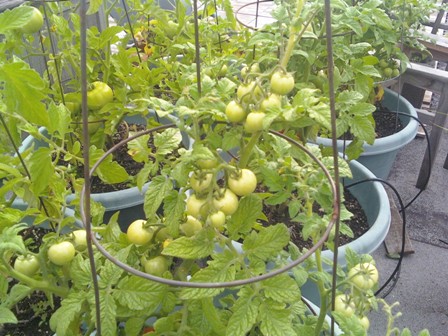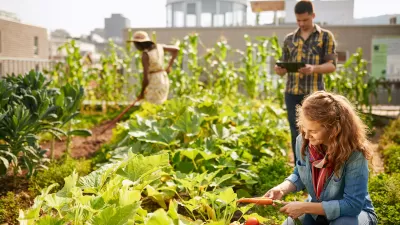I can’t deny that one of my strongest personality traits is that of being a hard-core cheapskate. So much so, that I feel obliged to caveat this post by saying that my initial reasons for getting into rooftop gardening were more to save money on buying fresh vegetables and fruit from our rather pricey local markets than any particular affection for gardening. While it turns out that my wife and I probably do save money (surprisingly, I never ran the numbers), the joy of gardening, and the kick I get out of showing our rooftop garden off to friends, has far outweighed the economic benefits. As counter-intuitive as it sounds, urban gardening is much easier than you might imagine. The hardest part is overcoming the psychological hurdle of thinking that it is difficult, confusing, time-consuming, or takes up lots of space. In fact, it is none of these things; you don’t need expensive, special equipment, or any particular skill. You only need a window box, a fire escape, or a small patch of patio if that’s all you have. If this geeky transportation engineer can grow tomatoes, so can you!
I can't deny that one of my strongest personality traits is that of being a hard-core cheapskate. So much so, that I feel obliged to caveat this post by saying that my initial reasons for getting into rooftop gardening were more to save money on buying fresh vegetables and fruit from our rather pricey local markets than any particular affection for gardening. While it turns out that my wife and I probably do save money (surprisingly, I never ran the numbers), the joy of gardening, and the kick I get out of showing our rooftop garden off to friends, has far outweighed the economic benefits. As counter-intuitive as it sounds, urban gardening is much easier than you might imagine. The hardest part is overcoming the psychological hurdle of thinking that it is difficult, confusing, time-consuming, or takes up lots of space. In fact, it is none of these things; you don't need expensive, special equipment, or any particular skill. You only need a window box, a fire escape, or a small patch of patio if that's all you have. If this geeky transportation engineer can grow tomatoes, so can you!

Tomatoes are easy, they need larger containers, support, and water!
Getting started is simple; you only need containers, potting mix (not soil), and plants. If you are in and older building, you are advised to get some reliable advice on the load capacities of your particular roof/fire escape/balcony. Gardening off the ground means using containers and lightweight potting mix. Any vessel that will hold soil, water, and keep its form against the elements will do. Fortunately, suitable containers are only as expensive as your taste allows. The absolute cheapest option is to check my beloved Craigslist for people offering suitable containers for free. I've seen dresser drawers and leaky aquariums put to good re-use. Next step up is looking for cheap, old five-gallon buckets or planters. If you aren't so environmentally obsessed with reusing materials as I am, new five-gallon buckets are about $3 at big box discount stores. We have an eclectic assortment of cheap/free containers from various finds over the years; but the flowers and edible plants blooming above them catch the eye more than the odd shapes and colors of the containers below. Either poke some drainage holes in the bottoms or consider the brilliant neo-urban, no-fuss gardening technique called "Sub-Irrigated Containers" (SIC).
Start with cheap potting mix (not soil) from the store. If you have space and are diligent about composting your weeds, trimmings, and dead annuals in a large container through the off- season, you will likely never need to buy potting mix again (if you take the next step and compost your food scraps, it's guaranteed!). Finally, since it's already mid-summer, you may want to buy this year's crop as small starter-plants, but next year you can start earlier indoors with seed packets for next to nothing. Tomatoes, strawberries, summer squash, lettuce, and blueberries are easy fruit/vegetable options. Chives, basil, cilantro, mint, rosemary, and oregano are simple starter herbs.
Planting your selection in containers is different than a ground garden. In containers, you can maximize your space by mixing different plants in the same container based on size to form a bouquet of sorts. Tomatoes are big plants and need support (sticks/string or cages) as they grow taller. Place these and other larger plants in the center of your containers, rimmed with smaller herbs and flowers as you like. It is true that certain plants complement each other's growth, but those are more advanced details. Don't worry too much at this point about soil pH, I haven't for the past three years and we still get good results. Once your bouquets are nicely planted, follow plant tag advice for sun/shade and water requirements. If your containers have holes in the bottom, the traditional drench-and-drain method involves daily watering (especially tomatoes) to keep things growing nicely. You can miss watering occasionally, but expect to see some wimpy leaves after a long weekend away. You can also set up a simple drip-irrigation system if you want to leave the watering to gravity. A 10-gallon trash can and a cheap drip irrigation starter kit works well for a small container garden. If you are trying out SIC, less-frequent watering is more easily worked into a hectic city life.
Expect to reserve one bright, warm day to get your garden up and growing. Many helpful sites for the burgeoning urban gardener are just a google search away, and some printed classics such "McGee and Stuckey's Bountiful Container" (affectionately referred to as "The Girls" in our home), are worth having handy for rainy-day perusal. With just a little patience, attention to weeds and water, you will be eating the freshest tomatoes, berries, and herbs you've ever tasted in just a few months!

Maui's Vacation Rental Debate Turns Ugly
Verbal attacks, misinformation campaigns and fistfights plague a high-stakes debate to convert thousands of vacation rentals into long-term housing.

Planetizen Federal Action Tracker
A weekly monitor of how Trump’s orders and actions are impacting planners and planning in America.

In Urban Planning, AI Prompting Could be the New Design Thinking
Creativity has long been key to great urban design. What if we see AI as our new creative partner?

Massachusetts Budget Helps Close MBTA Budget Gap
The budget signed by Gov. Maura Healey includes $470 million in MBTA funding for the next fiscal year.

Milwaukee Launches Vision Zero Plan
Seven years after the city signed its Complete Streets Policy, the city is doubling down on its efforts to eliminate traffic deaths.

Portland Raises Parking Fees to Pay for Street Maintenance
The city is struggling to bridge a massive budget gap at the Bureau of Transportation, which largely depleted its reserves during the Civd-19 pandemic.
Urban Design for Planners 1: Software Tools
This six-course series explores essential urban design concepts using open source software and equips planners with the tools they need to participate fully in the urban design process.
Planning for Universal Design
Learn the tools for implementing Universal Design in planning regulations.
Gallatin County Department of Planning & Community Development
Heyer Gruel & Associates PA
JM Goldson LLC
City of Camden Redevelopment Agency
City of Astoria
Transportation Research & Education Center (TREC) at Portland State University
Jefferson Parish Government
Camden Redevelopment Agency
City of Claremont





























